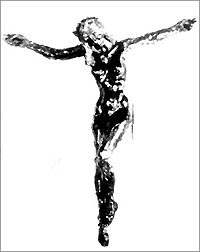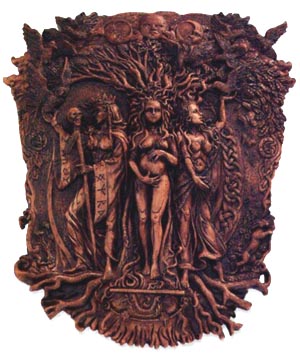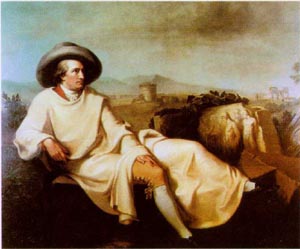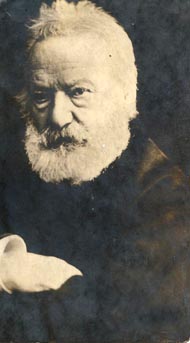 |
Consequences of Vatican II
Is God Mother?
Background of a Pontifical Statement
Atila Sinke Guimarães
During his brief pontificate, Pope John Paul I made this innovative statement: “God is Father, and even more, He is Mother.” The assertion was received with surprise in innumerable Catholic circles and with undisguised joy among the more radical progressivists.
For example, Leonardo Boff, one of the primary exponents of “liberation theology,” took advantage of the precedent by writing the book The Maternal Face of God. This work defends a series of theological eccentricities, including the thesis that the Holy Spirit would be “feminine.” Boff is a follower of Karl Jung, disciple of Sigmund Freud. For both Jewish-German philosophers, each human being would have both sexes, and the one that predominates and defines the person would be only the tip of the iceberg of androgynism, which would underlie the whole human psychology. I do not believe it necessary to show that this thesis is contrary to Catholic doctrine since I think everyone is aware of this.
During a trip from Reykjavik to Helsinki (June 1989), Pope John Paul II gave the following answer to one of the reporters on the plane, who interviewed him about the meaning of his Apostolic Letter Mulieris dignitatem:
“I believe that the situation of women today perhaps can be defined as being the ‘eternal feminine.’ I am seeking the eternal feminine. Everything that is accidental and animated by situations and circumstances cannot change the eternal, which is essential. In this respect, I expressed what I seek and desire in the document about the dignity of women.” The expression “eternal feminine,” charged with strange connotations, the Pontiff employed mainly to give greater emphasis to the role of women in present day society. Therefore, the principal novelty resided in the “blessing” given to the expression “eternal feminine.”
On September 8 (1999), the same Pope praised God as Mother, thus reaffirming indirectly the act of his predecessor. In fact, commenting on the Prodigal Son, John Paul II said:
“The father who embraces his lost son is the definitive icon of God…. The merciful father of the parable has in himself …. all of the characteristics of fatherhood and motherhood. In embracing the son he shows the profile of a mother.”
This statement, along with the previous declaration, spotlights the strange doctrine of the “eternal feminine.”
God cannot be symbolized equally by man or woman

A crucifix representing Jesus Christ with a feminine figure by sculptress Edwina Sandys |
The nature of God is spiritual. He is a pure spirit and, as such, has no sex, since this is a characteristic of living material beings turned toward the perpetuation of the species. Thus both sexes are reflected in God and should be considered made in the image and likeness of Him. However, it is not correct that God can be symbolized equally by man or woman.
In the man the image and likeness of God is properly expressed, but in the woman this exists to the measure in which she participates in the very plenitude of the man. The woman was created for the man - to be spouse, mother, or daughter - while the man was created to rule the material universe, to govern his equals and, in this way, to serve and glorify God. Therefore, the man is, from this aspect, the proper symbol of God, while the woman is the symbol by participation. Therefore, it is inadequate to refer to God as woman.
In fact, St. Paul teaches that “The man, indeed, ought not to cover his head, because he is the image and glory of God; but the woman is the glory of the man.” (1 Cor. 11:7) Commenting on this passage, the famous 16th-century exegetic, Fr. Cornelius a Lapide, S.J. notes:
“The Apostle says here that man is the image and glory, that is, the image of the glory or glorious image of God, in which shines principally his majesty and rule, because the man was placed in this world in a supreme level over all the things, dominating over all things as a secondary ‘god.’”
Further on a Lapide continues, dealing with the words “but the woman is the glory of the man”:
“The woman was made from the man and for his glory, that is to say, as his work and image. Thus, she became subject to him and as a sign of this subjection, her head should be covered. The woman, that is, the spouse, is the glory of man, that is, his glorious image, as I said above, because God formed Eve from the man, to his likeness so that she would represent his image and likeness. This image is found in the mind and in the reason, because the woman, like man, was provided with a rational soul, intellect, will, memory, liberty, being capable of wisdom, grace and glory, the same as the man. Consequently, the woman is the image of the man, not in the proper sense, because the woman is equal to the man as far as having a rational soul, and both were made in the image of God, but improperly and analogically, because the woman, who was made after the man and inferior, was made from the man and created similar to him.
"Thus the Apostle significantly does not say that the woman is the image of the man, but only: ‘the woman is the glory of the man.’ For, in truth, the woman is the eminent ornament of man, having been given to him either as collaborator in the propagation of children and in the government of the family, or as the subject of the exercise of his power, over which the man should exercise his jurisdiction and his dominion.”
This is the reason why in the Old and New Testaments, the Holy Ghost inspired the sacred writers to speak of God as King, Lord, Father, Bridegroom, etc. Also Jesus Christ, both God and Man, is not a woman. When He prayed, He always directed himself to the First Divine Person using the title of Father. In His teaching, Our Lord employed metaphors in the same sense: the owner of the vineyard who travels and leaves the government of his land to another; the father who marries his daughter and successively invited the noble and wealthy to the wedding feast, and then the poor and beggars of the street; the good pastor who watches over his sheep and seeks out each one that strays from the flock, etc. The only exception that I can recall is the metaphor of the hen protecting her chicks under her wings, which was used by Our Lord to express His affectionate protection for the Chosen People when he wept over Jerusalem on the vespers of the Passion. But, like every isolated case, the metaphor of the hen is not sufficient to change the constant teaching of the Holy Church that has always referred to God by using the figure of a man.
Thus, there are five powerful arguments that serve well to designate God as a man:
1. the fact that man is the image of God in the proper sense;
2. the fact that the Divine Word became incarnate as a man;
3. the fact that the Holy Ghost inspired the sacred authors to employ metaphors that consider God as a man;
4. the fact that Our Lord directed Himself to God the Father as a man in His prayers and in His teaching;
5. the fact that the Church has always directed itself to God as Father, Son and Holy Ghost.
Strange doctrines on the “Feminine”
Throughout History, innumerable pagan religions that invented stories to try to explain the origin and end of man and the universe had recourse to feminine principles: The Egyptians with the goddess Isis, the Assyrians with Astarte, the Greeks with Demeter, the Romans with Juno. These sects influenced the chosen people in various phases along their bumpy road of infidelity in the Old Testament. It resulted in a certain amalgam of errors that also included parcels of the true revealed doctrine.
 Pagan feminine deities Pagan feminine deities |
In my judgment, one of the main synthesis of these errors was expressed by the Jewish philosopher Philo of Alexandria (1st century) in a language that constituted one of the most complete expressions of what is called gnosis (knowledge), understood as the common denominator of the erroneous doctrines. Philo also considered supreme wisdom as “mother.” Innumerable studies point out the influence of these ancient religions, gnosis and the presence of the feminine element of the divinity on Judaic religious ideas. A significant example can be found in the Zohar (“Book of Splendor”), which, as far as I know, is the principal reference point that contains the doctrine of the Jewish Kabala (kabala= secret oral tradition). In it the divinity is composed of 10 sephirot (spheres), divided into couples with both feminine and masculine elements.
In the days of the early Church, either influenced by Greek thinking or Judaic errors, some heresies took on similar ideas, supposing an initial feminine element in the divinity itself. I believe that a principal expression of this tendency was the heresy of Valentinus, which presents Sophia Acamoth (the Passion of the Wisdom), as a universal feminine element. This heresy adapted many of erroneous concepts prior to the coming of Our Lord to the religious terminology in use after His coming. Outcroppings of the same errors continued to show up here and there for a long time.
Among the strange doctrines there is also that of the “Ophidians” (ophis, in Greek, serpent) who adored the serpent who appeared to Eve in Paradise. In direct revolt against God, they consider that God is the usurper who temporarily holds divine power. The God of the Catholic doctrine would be the black-god who, by an astute artifice, imprisoned the white-god and came to exercise the divine power. We are looking here at the dangerous tree of divine dualism and theosophism. From this comes the Ophidian sect, just one of its branches. The true god would be the present prisoner, the demon. Eve, hearing the voice of the serpent and inducing Adam to sin, would have begun to break the power of the usurper. For this reason, she is the object of a special cult, not much different from a divine cult. Again, the divination of the feminine.
In the Middle Ages, various Arab sects contaminated certain Catholic milieus. It is said that an “ecumenical” wing of the Templars, after militarily defeating the followers of the sect of Old Man of the Mountain, called “hashishini” (famous Muslim warriors who fought ferociously under the effect of a drug, hashishe), would have been influenced by its doctrine. According to it, the divinity to be adored would be an androgynous individual that would have some characteristics of an angel and others of a man-woman. Various books point to this being as the demon Baphomet.
There was also the cult of Lilith, which came from Judaism, which infiltrated some medieval ambiences. Lilith is considered the evil and dark side of the feminine.
The “Eternal Feminine” in literature
Some scholars have held that in the Divine Comedy, Dante made allegorical references to the “eternal feminine” in the idealized figure of Beatrice. Among the commentators that I know, the most emphatic in this regard is Cardinal Urs von Balthasar. It seems to me that this interpretation of the Florentine poet is certainly open to discussion.
The Romantic movement of the 18th and 19th centuries exalted the feminine. In his second Faust, Goethe closed the famous literary work exalting the “eternal feminine”. These are the last verses of the poem:

Goethe |
“Everything that can be perceived
is only a symbol;
the imperfect, which cannot be realized,
here makes itself reality;
that which cannot be described,
here finally completes itself.
It is the eternal feminine,
always attracting us to the higher.”
Goethe is said to have coined the expression “eternal feminine” that today has attracted the attention of Popes and theologians. To anyone reading Goethe without a special course, which was my case, the doctrine of the “eternal feminine” is somewhat unclear throughout the poem. The final reference of the second Faust invites a more profound analysis in order to find the mysterious personage girdled in sibylline phrases. I have my copy marked at the more curious places, but I have not had time to compare interpretations.
Chateaubriand in his Memoires d’Outre Tombe (Memories from Beyond the Grave) imagines the existence of a nymph or a sylph, an abstract feminine person immanent in every woman, that enchanted him throughout the course of his life. This immanence, for him, would have been unleashed by his various romantic experiences and formed an abstract reality that he personalized in something like an angel. He communicated lyrically with this personage in interior monologues that he consigned to paper with the aristocratic sense and incomparable literary talent peculiar to him.
In Chateaubriand, by applying the inductive method to the experimental reality, one has the idea of the most intelligent and accessible meaning of what would be the “eternal feminine.” One could say that this “eternal person” would have the beauty, charm, goodness, delicacy and affection that are peculiar of women. Throughout history, women would have had such characteristics by possessing immanently in themselves the presence of this mysterious nymph.

Victor Hugo |
Philosophically, we are in the ambit of the errors of immanence, so frequent in Romantic thinking: two individuals who are meshed essentially into only one. It is the initial error of spiritualist pantheism, and it is the final error of evolutionist materialism. Therefore, it deserves to be completely rejected. However, such an explanation based on Chateaubriand has at least the merit of accessibility and an attractive presentation. It is mythology that presents itself clearly, elegantly and with the power to seduce. This is quite different from the incoherent and arbitrary legends of the Eastern religions, of the banal secrets of occultism, of the erotic obsession of the Kabala, or of the deceitful methods of the gradual initiations that live by promising wisdom to fools, who are incapable of understanding it.
In a certain way Victor Hugo also touched on the theme of the feminine. In his poem, La Fin de Satan (The End of Satan), which seems to me the key to understanding his famous, brilliant and fragmented work La Legende des Siècles (The Legend of the Centuries), he gives a decisive role to a feminine element - the Angel Liberty. This celestial angel, who was the favorite daughter of Lucifer before his fall, asks permission from God to go to Hell to deal with Satan. After a tragic and difficult dialogue, the feminine charm and affection of the Angel Liberty manages to convince the Demon to reconcile himself with God.
In this case, there is no longer the description of the nature of the feminine, but the principal end of her function: the reconciliation of the Demon with God. Incidentally, the same reconciliation is exalted in the Hymn to Joy of Schiller, when he imagines the fallen Cherubim presenting himself before God. Beethoven placed the piece of Schiller in the center of his Ninth Symphony to express in grandiose chords the reconciliation between the good and the evil. In theological terms, this is the reestablishment of an ancient heresy that seduced some Catholic thinkers in the beginning of the Church - the apokatastaze. This Greek term, composed of strong consonants and incisive sounds, signifies that at the end of history God will pardon the reprobates and the demons, and that Hell will no longer have any reason to exist. The recent allocution of John Paul II about Hell seems to make this apokatastaze current for our times.
The “Feminine” and Progressivism
Some schismatic Russian thinkers have a special Trinitarian system of thought, “Sophianism,” according to which Sophia (Wisdom) would also have a feminine element. In some sketchy studies I made, it seemed to me that Bulgakov is the most characteristic representative of “Sophianism.”
Teilhard de Chardin, the well-known French Jesuit who died in the U.S. in 1955, is considered one of the precursors of conciliar thinking. He wrote a work entitled L’Eternel Feminin (The Eternal Feminine). His friend and defender, Cardinal Henry de Lubac, made a commentary on this work, and then gave his study the same name, L’Eternel Feminin. In these works, Teilhard and de Lubac propose that the “eternal feminine” is a type of outer covering of God - something that would have existed from all times enveloping the divinity. The expression employed by Teilhard is the “envelope of God.” It would be a type of feminine charm that would envelop the Trinity and attract the Trinity to realize divine “movements,” that is to say, the Creation of the universe and the Incarnation of the Word. The three Trinitarian Persons would have had a romantic “weakness” and been charmed by the attributes of the “eternal feminine.”
In another work - Écrits du Temps de la Guerre (Writings from Wartime) - Teilhard draws closer to this element of Wisdom described poetically in the Book of Ecclesiastics (Chaps. 24-25). In the Creation the “eternal feminine” would be what attracts men to God, and God to men. This “feminine” would be immanent and would be what impelled men toward every type of union among themselves. Departing from this insertion of the “feminine” into the Trinity, Creation and the Redemption, Teilhard places it into all of theology. It is a reinterpretation of theology that transforms it into something quite different from Catholic Theology. Nonetheless, in 1981 John Paul II, by means of Cardinal Casaroli, sent a letter praising Teilhard de Chardin to Cardinal Paul Poupard, Rector of the Institut Catholique of Paris, for the symposium on the French Jesuit that was taking place there.
This is the background of the picture I would like to present to the reader so that he can judge objectively the gravity of the pontiff praising God as Mother.
Final questions
The background established, questions naturally arise in the perplexed spirit of some Catholics. Questions for which I have no response, but which impose themselves nonetheless.
- Why did John Paul II, imitating his predecessor, decide to change the tradition of Catholic teaching and qualify God as Mother?
- Was he aware that by doing this, he opens the sacred doors of Catholic doctrine to theories quite foreign to orthodoxy, such as those that I mentioned?
- Would this signify a desire to “baptize” such theories and give them right of citizenship in the Catholic milieu?
If this hypothesis is objective, under these conditions would not a Pontiff call upon himself the prior condemnations of the infallible Magisterium? If it is not objective, how can the pontifical statement be truthfully explained?

|
Feminism | Hot Topics | Home | Books | CDs | Search | Contact Us | Donate

© 2002- Tradition in Action, Inc. All Rights Reserved
|
 |
|